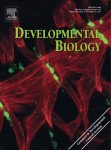Dec 11
22
 Researchers at the UMKC School of Biological Sciences have identified a key protein that is essential in the development of proper muscle-tendon attachment and maintaining muscle strength and mobility. The results of the research were published and featured as the cover story in the Journal of Developmental Biology.
Researchers at the UMKC School of Biological Sciences have identified a key protein that is essential in the development of proper muscle-tendon attachment and maintaining muscle strength and mobility. The results of the research were published and featured as the cover story in the Journal of Developmental Biology.
Cindy Liu, a fourth-year graduate student working in the lab of Assistant Professor Erika Geisbrecht, Ph.D., served as lead author of the research publication.
“When muscles contract, they must be stably attached at the ends of the muscle for proper force generation,” Geisbrecht said. “The myotendinous junction, or MTJ, is the site where muscles must attach to tendon cells. If the MTJ does not develop correctly, or if a strong muscle-tendon attachment site is not properly maintained, muscles cannot contract. This results in a loss of normal muscle movement.”
Using the model organism Drosophila melanogaster (common fruit fly), Liu and Geisbrecht identified the role of the protein Moleskin (Msk) in the development and maintenance of muscle-tendon attachment. Msk is recognized as an “evolutionarily conserved protein,†which means that it has a similar function both in flies and vertebrates. The human counterpart of Msk is known as Importin-7.
“Both vertebrate and Drosophila Importin-7 are well-known for their roles in the import of proteins into the nucleus to regulate gene expression,” Geisbrecht said. “Surprisingly, we found that Msk protein is not localized to the nucleus in muscle cells like it is during other stages of embryonic development. Instead, Msk protein is found at the sites of muscle-tendon attachment, where it signals from the muscle to the tendon cell to regulate adhesion at the MTJ.”
Liu and Geisbrecht found that embryos that do not have functional Msk protein are defective in muscle-tendon attachment. They observed that muscles in “msk-mutant” embryos appear to form correctly and migrate to the site where the muscle and tendons need to meet to form a stable MTJ. However, proper adhesion between the muscle and tendon cell is compromised once muscle contraction begins, leading to a “round” muscle that had lost its ability to remain attached and generate force during muscle contractions.
“This finding is important because it identifies a new function for the Msk protein and adds a missing puzzle piece to understanding the entire process of MTJ formation,” Geisbrecht said. “Other research studies have shown that the loss of a stable MTJ in vertebrate research models results in progressive myopathies, or muscle diseases.”
Furthermore, she added, humans with mutations in genes essential for MTJ stability show a decrease in the ability to maintain normal muscle function. As similar strategies of muscle development and maintenance occur among invertebrates, including flies, and mammalian systems, these studies may provide insights into the genetic cause of human muscular diseases. The long-term goal of the Geisbrecht laboratory is to identify and characterize genes required in both muscle development and muscle maintenance. In addition to the recent journal publication, Liu will be presenting the results of their research at the 2012 Drosophila Research Conference in Chicago.
